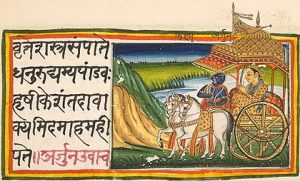Difference between revisions of "Language/Sanskrit/Grammar/Conditional-Mood"
m (Quick edit) |
m (Quick edit) |
||
| Line 7: | Line 7: | ||
__TOC__ | __TOC__ | ||
<span link>Consider broadening your understanding by checking out these related lessons: [[Language/Sanskrit/Grammar/Give-your-Opinion|Give your Opinion]], [[Language/Sanskrit/Grammar/How-to-Use-Be|How to Use "Be"]], [[Language/Sanskrit/Grammar/Plurals|Plurals]] & [[Language/Sanskrit/Grammar/Gender|Gender]].</span> | |||
== Formation of the Conditional Mood == | == Formation of the Conditional Mood == | ||
| Line 34: | Line 36: | ||
<br><hr>If you have any questions, please ask them in the comments section below.<br>Feel free to edit this wiki page if you think it can be improved. 😎 | <br><hr>If you have any questions, please ask them in the comments section below.<br>Feel free to edit this wiki page if you think it can be improved. 😎 | ||
==Other Lessons== | |||
== | |||
* [[Language/Sanskrit/Grammar/Plurals|Plurals]] | * [[Language/Sanskrit/Grammar/Plurals|Plurals]] | ||
* [[Language/Sanskrit/Grammar/Negation|Negation]] | * [[Language/Sanskrit/Grammar/Negation|Negation]] | ||
| Line 46: | Line 46: | ||
* [[Language/Sanskrit/Grammar/How-to-Use-Be|How to Use Be]] | * [[Language/Sanskrit/Grammar/How-to-Use-Be|How to Use Be]] | ||
* [[Language/Sanskrit/Grammar/How-to-Use-Have|How to Use Have]] | * [[Language/Sanskrit/Grammar/How-to-Use-Have|How to Use Have]] | ||
<span class='maj'></span> | <span class='maj'></span> | ||
| Line 55: | Line 54: | ||
{{Sanskrit-Page-Bottom}} | {{Sanskrit-Page-Bottom}} | ||
<span links></span> | |||
Latest revision as of 21:00, 27 March 2023
Hi Sanskrit learners! 😊
In today's lesson, we will be discussing the conditional mood in Sanskrit grammar. The conditional mood is used to express a hypothetical situation or an event that may or may not happen in the future. It is also used to express a wish or a desire.
Consider broadening your understanding by checking out these related lessons: Give your Opinion, How to Use "Be", Plurals & Gender.
Formation of the Conditional Mood[edit | edit source]
The conditional mood is formed by adding the suffixes त्याग् (tyāg) or त्यागे (tyāge) to the root of the verb. The suffix त्याग् (tyāg) is used for the first person singular and plural, and the third person singular and plural. The suffix त्यागे (tyāge) is used for the second person singular and plural.
Examples[edit | edit source]
- First Person Singular: गच्छत्याग् (gacchatyāg) - I may go
- Second Person Singular: गच्छत्यागे (gacchatyāge) - You may go
- Third Person Singular: गच्छत्याग् (gacchatyāg) - He/She/It may go
- First Person Plural: गच्छत्याग् (gacchatyāg) - We may go
- Second Person Plural: गच्छत्यागे (gacchatyāge) - You may go
- Third Person Plural: गच्छत्याग् (gacchatyāg) - They may go
Usage of the Conditional Mood[edit | edit source]
The conditional mood is used to express a hypothetical situation or an event that may or may not happen in the future. It is also used to express a wish or a desire.
For example, if you want to say "I wish I could go to the beach", you would use the conditional mood: मी समुद्रात जाण्याची श्रेय गच्छत्याग् (mī samudrāt jāṇyācī śrey gacchatyāg).
The conditional mood can also be used to express a hypothetical situation or an event that may or may not happen in the future. For example, if you want to say "He might go to the beach", you would use the conditional mood: त्याला समुद्रात जाण्याची शक्यता आहे (tyālā samudrāt jāṇyācī śakyatā āhe).
Conclusion[edit | edit source]
In this lesson, we discussed the formation and usage of the conditional mood in Sanskrit grammar. We saw how the suffixes त्याग् (tyāg) and त्यागे (tyāge) are used to form the conditional mood, and how it is used to express a hypothetical situation or an event that may or may not happen in the future, as well as to express a wish or a desire.
If you have any questions, please ask them in the comments section below.
Feel free to edit this wiki page if you think it can be improved. 😎
Other Lessons[edit | edit source]
- Plurals
- Negation
- Future Tense
- Adjectives
- Questions
- Pronouns
- Give your Opinion
- How to Use Be
- How to Use Have
Sources[edit | edit source]
- The conditional mood | Learn Sanskrit Online
- Lesson 27 – The future tenses and the conditional | our sanskrit
- Conditional Verbs | Learn Sanskrit Online
